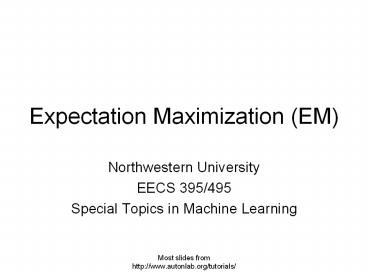Expectation Maximization (EM) PowerPoint PPT Presentation
Title: Expectation Maximization (EM)
1
Expectation Maximization (EM)
- Northwestern University
- EECS 395/495
- Special Topics in Machine Learning
2
Outline
- Objective
- Simple example
- Complex example
3
Objective
- Learning with missing/unobservable data
B
E
E B A J 1 1 1 1 1 0 1 1 0 0 0
0
A
Maximum likelihood
J
4
Objective
- Learning with missing/unobservable data
B
E
E B A J 1 1 ? 1 1 0 ? 1 0 0 ?
0
A
Optimize what?
J
5
Outline
- Objective
- Simple example
- Complex example
6
Simple example
7
Maximize likelihood
8
Same Problem with Hidden Information
Grade
Hidden
Score
- Observable
9
Same Problem with Hidden Information
10
Same Problem with Hidden Information
11
EM for our example
12
EM Convergence
13
Generalization
- X observable data (score h, c, d)
- z missing data (grade a, b, c, d)
- model parameters to estimate ( )
- E given , compute the expectation of z
- M use z obtained in E step, maximize the
likelihood with respect to
14
Outline
- Objective
- Simple example
- Complex example
15
Gaussian Mixtures
16
Gaussian Mixtures
- Know
- Data
- -
- -
- Dont know
- Data label
- Objective
- -
17
The GMM assumption
18
The GMM assumption
19
The GMM assumption
20
The GMM assumption
21
The data generated
Label
Coordinates
22
Computing the likelihood
23
EM for GMMs
24
EM for GMMs
25
EM for GMMs
26
(No Transcript)
27
(No Transcript)
28
(No Transcript)
29
(No Transcript)
30
(No Transcript)
31
(No Transcript)
32
(No Transcript)
33
(No Transcript)
34
Generalization
- X observable data
- z unobservable data
- model parameters to estimate
- E given , compute the expectation of z
- M use z obtained in E step, maximize the
likelihood with respect to
35
For distributions in exponential family
- Exponential family
- Yes normal, exponential, beta, Bernoulli,
binomial, multinomial, Poisson - No Cauchy and uniform
- EM using sufficient statistics
- S1 computing the expectation of the statistics
- S2 set the maximum likelihood
36
What EM really is
- X observable data
- z missing data
- Maximize expected log likelihood
- E-step Determine the expectation
- M-step Maximize the expectation above with
respect to
37
Final comments
- Deal with missing data/latent variables
- Maximize expected log likelihood
- Local minima
PowerShow.com is a leading presentation sharing website. It has millions of presentations already uploaded and available with 1,000s more being uploaded by its users every day. Whatever your area of interest, here you’ll be able to find and view presentations you’ll love and possibly download. And, best of all, it is completely free and easy to use.
You might even have a presentation you’d like to share with others. If so, just upload it to PowerShow.com. We’ll convert it to an HTML5 slideshow that includes all the media types you’ve already added: audio, video, music, pictures, animations and transition effects. Then you can share it with your target audience as well as PowerShow.com’s millions of monthly visitors. And, again, it’s all free.
About the Developers
PowerShow.com is brought to you by CrystalGraphics, the award-winning developer and market-leading publisher of rich-media enhancement products for presentations. Our product offerings include millions of PowerPoint templates, diagrams, animated 3D characters and more.

